
- The Angio-seal Device
- Compressive strength sealing
- Step By Step Instructions
- Technical specifications
- Advantages of Angio-seal on manual compression
- Advantages of angio-seal on other mechanical closure devices
- Angio-Seal related Cases
- Videos of the Angio-Seal
- Photos of Angio-seal device
- Leaflets, brochures and articles
Controlled Deployment for Confident Closure
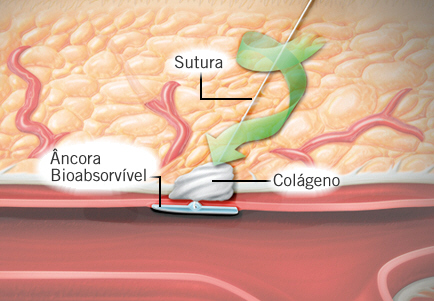
Angio-Seal Evolution features a standardized deployment system that is designed to assist in overcoming many procedural variables and deliver a virtually instantaneous seal of the arteriotomy. It may also support increased confidence in the number of cases where the use of a mechanical seal is possible. The Angio-Seal ™ Evolution ™, which is the eighth generation of the recognized platform for vascular closure devices, includes improvements designed to increase the reliability and ease of use.
Angio-Seal Evolution features the fully bioabsorbable Active Closure System with an innovative intra-arterial anchor, suture and collagen seal. Designed to hold the system in place, the Active Closure System provides rapid, safe and reliable hemostasis.
Standardized implant
The automated implant provides greater control over the entire process, which can reduce the variability of procedures and meet the requirements of a larger number of cases.
Immediate compression
Controlled implant starts immediately with a homogeneous compaction of collagen, which lets you control the arteriotomy and thus form a perfect seal.
Compressive strength sealing
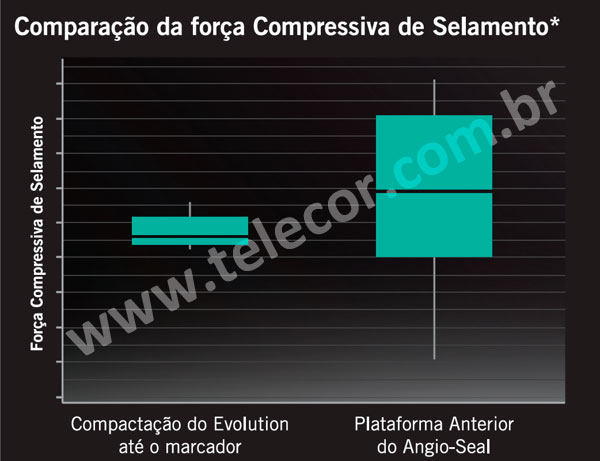
The compressive sealing force is predetermined force which exists between the anchor and the collagen arteriotomy when is finalized the implant Angio-Seal device. All forces measured are less than 454g. Tests show consistency in the internal compressive force to the sealing device Angio-Seal Evolution compared to the variability observed in previous platforms
ANGIO-SEAL DEVICE INSERTION PROCEDURE
Step by Step:
- 1. Locate the Artery
- 2. Set the Anchor
- 3. Seal the Puncture
- 4. Release the Suture
1. Locate the Artery
Exchange procedure sheath with Angio-Seal Locator System.
- 1. Blood flow through the locator confirms sheath has entered the artery.
- 2. Confirm proper location by withdrawing and reinserting the Angio-Seal locator system until blood flow resumes and then STOP.
- 3. Remove locator and wire, leaving the sheath in place.
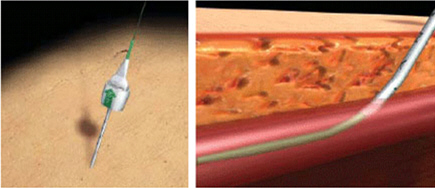
2. Set the Anchor
- 1. Carefully grasp the Angio-Seal device just behind the Bypass Tube and slowly insert into the sheath until you hear a click.
- 2. Maintain a grip on the Sheath Hub, grasp Device Handle, and gently pull back until you hear another click.
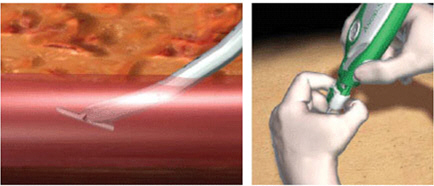
3. Seal the Puncture
- 1. Provide support to the puncture site with two fingers.
- 2. Gently pull back on the Angio-Seal Device Handle along the angle of the puncture tract.
- 3. Continue to pull back until hemostasis is achieved. As a guide, the colored compaction marker will be revealed.
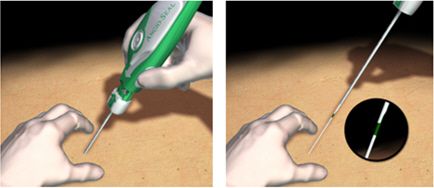
4. Release the Suture
- 1. Release and hold down the Suture Release Button.
- 2. Gently pull back on the device handle until the suture is exposed.
- 3. With tension on the suture, cut the suture below skin level.
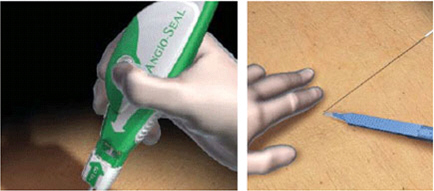
TECH SPECS
Reorder Number |
French Size |
Guidewire Diameter (in) |
C610134 |
6 |
0.035 |
C610135 |
8 |
0.038 |
Advantages of Angio seal on manual compression
Quick and Effective Hemostasis: Immediate and wide compaction coverage through the arteriotomy collagen promotes hemostasis almost instantaneous. Study 4
More Patient Satisfaction: Patients reported significantly less discomfort during and after vascular locks with the Angio-Seal device. Study 5
Clinical Efficiency and Turnover: Early ambulation and hospital discharge can significantly improve the overall cost-effectiveness and turnover in the halls of vascular procedures. Study 6
Low probabilities of Complications: Studies have shown that the Angio-Seal device can reduce the risk of complications at the access site in both procedures: diagnostic and interventional. Study 8, Study 9
Advantages of angio seal on other mechanical closure devices
Quick Wandering: The placement of an anchor with the closing of collagen provides reliable hemostasis and promotes rapid patient ambulation. Study 3
Easy Implant: Held with one hand, standardized implant reduces the risk of variability between different procedures.
Sealing Insurance: immediate sealing of the artery can be performed safely without increasing vascular complications. Study 7
Proven: more than 325 studies have shown that the Angio-Seal is a safe and effective device in a wide range of patients and procedures. Study 1, Study 2
Angio-Seal related cases

1. Martin JL, Pratsos A, Magargee E, Mayhew K, Pensyl C, Nunn M, Day F, Shapiro T. "A Randomized Trial Comparing Compression, Perclose Proglide™ and Angio-Seal VIP™ for Arterial Closure Following Percutaneous Coronary Intervention: CAP Trial." Catheterization and Cardiovascular Intervention January 2008;1-5
-
2. Nikolsky E, Mehran R, Halkin A, Aymong ED, Mintz GS, Lasic Z, Negoita M, Fahy M, Krieger S, Moussa I, et al. Vascular complications associated with arteriotomy closure devices in patients undergoing percutaneous coronary procedures: a meta-analysis. J Am Coll Cardiol 2004;44:1200 –1209
-
3. Angio-Seal Evolution Instructions For Use (Results of a clinical study demonstrate that patients that have undergone diagnostic angiography and have received a 6F Angio-Seal Device can safely and effectively ambulate in less than 20 minutes)
-
5. Duffin DC, Muhlestein JB, Allison SB, Horne BD, Fowles RE, Sorensen SG, Revenaugh JR, Bair TL, Lappe DL. "Femoral Arterial Puncture Management After Percutaneous Coronary Procedures: A Comparison of Clinical Outcomes and Patient Satisfaction Between Manual Compression and Two Different Vascular Closure Devices." J Invas Cardiol 2001;13:354-362
-
6. Resnic FS, Arora N, Matheny M, Reynolds MR. "A Cost-Minimizing Analysis of the Angio-Seal Vascular Closure Device Following Percutaneous Coronary Intervention." Am J Cardiol 2007; 99(6):766-770
-
7. Applegate RJ, Rankin KM, Little WC, Kahl FR, Kutcher MA. "Restick Following Initial Angio-Seal Use." Cathet. Cardiovasc. Interv. 2003; 58(2):181-184
-
8. Kussmaul WG, Buchbinder M, Whitlow PL, Aker UT, Heuser RR, King SB, Kent KM, Leon MB, Kolansky DM, Sandza JG. "Rapid Arterial Hemostasis and Decreased Access Site Complications After Cardiac Catheterization and Angioplasty: Results of a Randomized Trial of a Novel Hemostatic Device." J. Am. Coll. Cardiol. 1995; 25(7): 1685-1692
-
9. Arora N, Matheny ME, Sepke C, Resnic FS. "A propensity analysis of the risk of vascular complications after cardiac catheterization procedures with the use of vascular closure devices." Am Heart J. 2007 Apr;153(4):606-11
Video of the Angio-Seal Evolution – Advertiser
Video of the Angio-Seal Evolution – Procedure
Pictures of Angio-seal
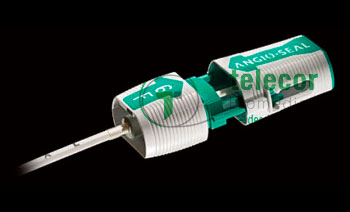
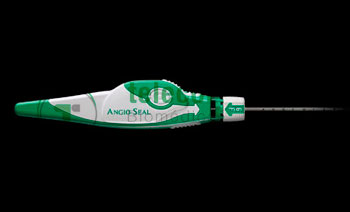
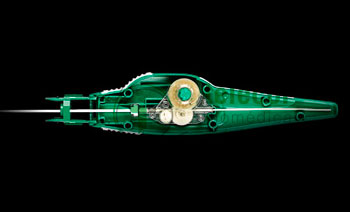
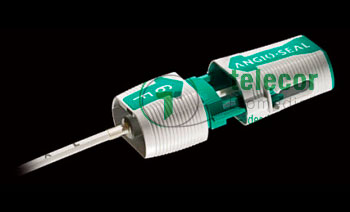
Leaflets, brochures and articles of Angio seal
- AngioSeal Evolution Registry Subset Whitepaper [PDF 175KB]
- AngioSeal Evolution Registry Whitepaper [PDF 102KB]
- Restick Brochure [PDF 288KB]
- Angio-Seal Evolution Brochure [PDF 1263KB]
- Improving Productivity with use of Angio-Seal [PDF 108KB]
- Angio-Seal Same-Day Discharge [PDF 118KB]
- Everyday Use of Angio-Seal for Interventional Radiology Procedures [PDF 92KB]
- Staged Procedures With Use of Angio-Seal [PDF 151KB]
Instructions for use
Please read the product manual for a complete description of Indications, Contraindications, Warnings, Precautions, Adverse Events and Potential Instructions for Use.
Producer

The above texts were taken from the manufacturer St. Jude Medical website. Product Price: On request.
